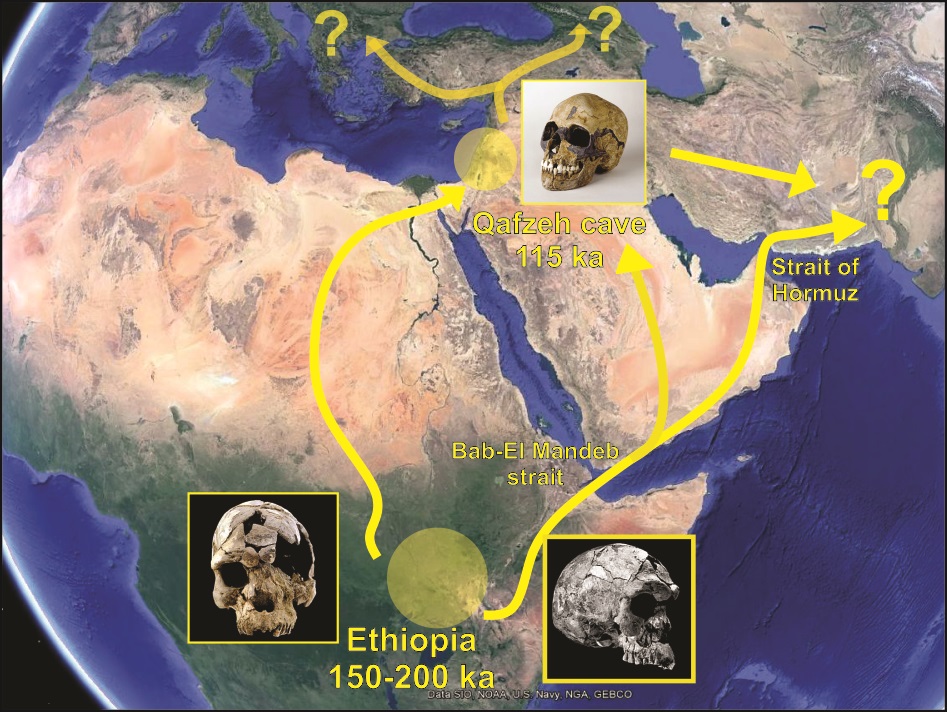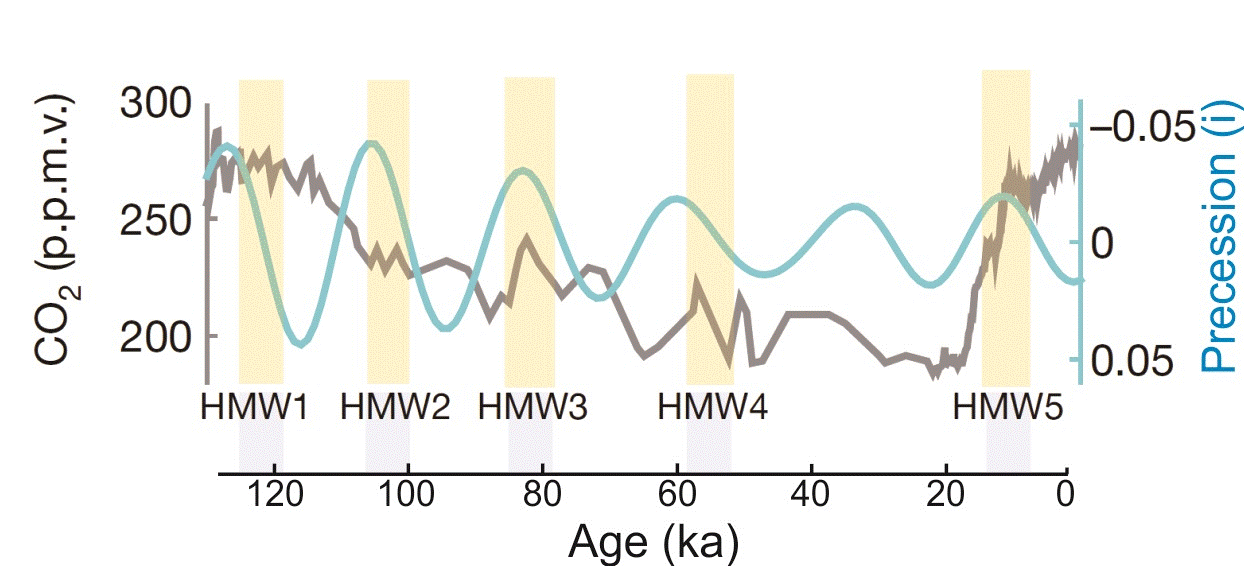by Ignacio Jara
It is now widely accepted that anatomically modern humans (Homo sapiens) emerged in Africa around 200 ka (ka=thousands of years before the present), as evidenced by now-classic hominid sites in eastern Africa and supported by genetic variations among modern populations. Despite the unquestioned African origin of our species, the time when modern humans first exited Africa and the order in which they colonised the remaining continents is hotly debated.
The most recent of these discussions has centred on the timing of the first exodus and its relationship with Quaternary climate variations1. This is clearly a subject that touches a wider and perhaps more complex topic such as the relationship between the evolution and behaviour of humans and their changing environment. This is an appealing subject which bears not only scientific relevance, but also deep cultural implications. For instance, the extent to which climate variability or other environmental drivers has influenced human migrations is a question that stresses the role of geography over culture.
Homo sapiens remains dating back to 125 ka during Marine Isotope Stage 5e (MIS 5e) have been found in modern day Israel. The commonly accepted view is that these remains represent an early human dispersal that failed to spread outside of the Middle East, becoming extinct soon after it stepped out of Africa. The peopling of Europe, Asia and Australasian was supposed to have occurred much later from a single “successful” migration around 70-60 ka1.
However, this view of a single successful migration is being challenged. In 2015, several modern human remains dated to at least 80 ka were found in the Fuyan Cave in southern China2. These findings followed a series of other surprisingly old human fossils in Asia, yet no remains of modern humans older than 50 ka have been found in Europe. This new evidence questioned the classic single “out of Africa” model, suggesting an alternative scenario where H. sapiens expanded eastward into Asia in one or more waves of migration starting well before 70 ka. While it is still unclear what prevented an early migration into Europe.
Back in 2013, Larrasoaña and collaborators combined a series of continental and marine records from northern Africa to propose what is, without question, an exciting idea for any Quaternarist: that orbital-driven Northern Hemisphere insolation played an important role in the migrations of hominids out of Africa3. It has long been noted that the 23-ka precession cycles are clearly imprinted on the Northern Hemisphere summer insolation between 300-60 ka. Every 23,000 years, decreased precession and corresponding high Northern Hemisphere summer insolation are linked to a northward shift of the Intertropical Convergence Zone. These shifts were, in turn, linked to northward expansion of the tropical belt bringing periods of intensified monsoon rainfall over northern Africa and the Middle East. During these humid intervals, the deserted regions of the Northern Africa, the Middle East and the Arabic Peninsula were transformed into savanna-like regions boasting freshwater lakes and extensive grasslands, becoming transient corridors for modern human populations to migrate out of Africa.
Exit passages for African H. sapiens were therefore opened with “orbital” regularity at around 130 ka (MIS 5e), 105 ka (MIS 5c), 82 ka (MIS 5a) and 60 ka (MIS 4-3). Thus it is not surprising that the earliest human fossils out of Africa found in Israel date back to MIS 5e. Furthermore, all the following wet intervals coincide with dated H. sapiens sites in Northern Africa, the Middle East or the Arabian Peninsula. There are several possible routes that the H. sapiens could have taken. The Sinai Peninsula in northern Africa was the most logical passage to exit Africa (Figure 1). However, there is an alternative southern route which connects eastern Africa with southern Asia via the narrow straits of Bab-El Mandeb and Hormuz. This route could have briefly been opened before the sea level rise associated with MIS 5e.
Figure 1 – Homo sapiens emerged in Africa around 200 ka. The older Homo sapiens remains outside of Africa are found in today’s Israel and date back to 125 ka during Marine Isotope Stage 5e. The timing and routes of the first expansion into the other continents is still in debate. For more information see: Stringer, C. (2003).
In an article published just last month, Timmermann and Friedrich (2016) take the idea of precession-controlled wet periods as a pacemaker for human dispersal and test it by running a human dispersal model4. Their new model, forced by environmental variables such as climate variability, sea level changes and the extension of deserts, is able to reproduce a series of independent migration pulses between 110-60 ka in broad alignment with the orbital moist intervals and the archaeological record of Northern Africa (Figure 2). By reproducing the dates for the first arrival time of H. sapiens in places like South China (100-70 ka), New Guinea and Australia (60 ka), and the Americas (14-10 ka), this new simulation provides new weight towards orbital variations as a key driver of early migrations of H. sapiens.
Figure 2 – Modern human Migration waves (HMW, yellow bars) occurred with “orbital” regularity at around 130 ka (MIS 5e), 105 ka (MIS 5c), 82 ka (MIS 5a) and 60 ka (MIS 4-3), when low precession (light blue, note the inverted scale) and resulting high Northern Hemisphere summer insolation resulted in a series of wet episodes in Africa and the Middle east. Atmospheric CO2 concentration curve (light grey) is shown as a reference. Modified from: Timmermann, A., & Friedrich, T. (2016).
Although the early exodus and multiple orbital dispersal model looks promising, several other issues need to be addressed in future investigations. For instance, the model presented by Timmermann and Friedrich indicates that H. sapiens stepped into Europe between 100-80 ka. This time is at odds with the archaeological record, which shows no evidence for modern humans before 45 ka. Interestingly, the authors suggest the possibility that the first H. sapiens populations in Europe where assimilated by the prevalent Neanderthal population before 50 ka. This hypothesis seems plausible considering the information provided by the recently-cracked genome of Neanderthals which gives hints of the incorporation of modern human genes into European Neanderthals DNA at around 100 ka5.
Together, Quaternary scientists, archaeologist and geneticists are providing exciting new information about past links between climate variability and ancient migrations. An active role of environmental variability in the distribution of modern humans across the globe has long been dismissed by paleo-anthropologists, ethnographers or linguistics who traditionally favoured cultural explanations over “geographic or climatic determinism” to account for ancient human migrations. Nonetheless, a bio-geographic approach to the peopling of the planet seems to be gaining ground. What it is perhaps even more fascinating to any Quaternarist is that a look at the Northern Hemisphere insolation curve shows that the potential number of humid events in Africa and the Middle East over the last 2 million years is in the order of thousands. Future paleoclimate studies and a more complete archaeological record will have the potential to test the role of climate events in the diaspora of previous hominid species as well as the emergence of our own species.
References
- Mellars, P., Gori, K. C., Carr, M., Soares, P. A., & Richards, M. B. (2013). Genetic and archaeological perspectives on the initial modern human colonization of southern Asia. Proceedings of the National Academy of Sciences, 110 (26), 10699-10704.
- Liu, W., Martinón-Torres, M., Cai, Y. J., Xing, S., Tong, H. W., Pei, S. W., & Li, Y. Y. (2015). The earliest unequivocally modern humans in southern China. Nature.
- Larrasoaña, J. C., Roberts, A. P., & Rohling, E. J. (2013). Dynamics of green Sahara periods and their role in hominin evolution. PloS one, 8 (10), e76514.
- Timmermann, A., & Friedrich, T. (2016). Late Pleistocene climate drivers of early human migration. Nature, 538 (7623), 92-95.
- Kuhlwilm, M., Gronau, I., Hubisz, M. J., de Filippo, C., Prado-Martinez, J., Kircher, M., & Rosas, A. (2016). Ancient gene flow from early modern humans into Eastern Neanderthals. Nature, 530 (7591), 429-433.

